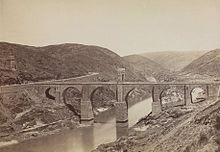Alcántara Bridge
You can help expand this article with text translated from the corresponding article in Spanish. (June 2019) Click [show] for important translation instructions.
|
Alcántara Bridge | |
|---|---|
 | |
| Coordinates | 39°43′21″N 6°53′33″W / 39.7224°N 6.8924°W |
| Crosses | Tagus River |
| Locale | Alcántara, Spain |
| Heritage status | Listed as cultural heritage since 1921[1] |
| Characteristics | |
| Design | Roman arch bridge |
| Material | Stone |
| Total length | 181.7 m (596 ft)[2] |
| Width | 8.6 m (28 ft)[2] |
| Height | 45 m (148 ft)[3] |
| Longest span | 28.8 m (94 ft)[4] |
| No. of spans | 6 |
| Load limit | 52 t (57 short tons)[5] |
| History | |
| Designer | Caius Julius Lacer |
| Construction start | 104 AD |
| Construction end | 106 AD |
| Location | |
 | |
The Alcántara Bridge (also known as Trajan's Bridge at Alcantara) is a Roman bridge at Alcántara, in Extremadura, Spain. Alcántara is from the Arabic word al-Qantarah (القنطرة) meaning "the arch". The stone arch bridge was built over the Tagus River between 104 and 106 AD by an order of the Roman emperor Trajan in 98.[6]
History


The Alcántara Bridge has suffered more damage from war than from the elements over the years. The
The bridge originally measured 190 m (620 ft) in length, which today is reduced to 181.7 m (596 ft).[2] The clear spans of the six arches from the right to the left riverside are 13.6 m (45 ft), 23.4 m (77 ft), 28.8 m (94 ft), 27.4 m (90 ft), 21.9 m (72 ft) and 13.8 m (45 ft).[4]
Construction
The bridge's construction occurred in the
| Original | Latin in full | Translation |
|---|---|---|
| Municipia provinciae Lusitaniae stip conlata quae opus pontis perfecerunt. Imp. Caesari divi Nervae f. Nervae. Traiano Aug. Germ. Dacico Ponti f. Max. Trib. potes VIII. imp. V. cos V. PP. | Caesar Imperator, son of divine Nerva, Nerva Traianus Germanicus Dacicus, Maximus Pontifex, Tribunitia Potestas for the 8th time, Imperium for the 5th time, Pater of the Patria | The municipalities of the province of Lusitania contributed to the construction of the bridge. The Emperor Caesar, son of divine Nerva, the German, the Dacian, Trajan, who was made three times Highest Priest, given eight times the Tribune power, and given five times the government; Father of the country |
| Original | Translation |
|---|---|
Pontem perpetui mansurum |
Permanent bridge will remain |
Gallery
-
Looking south, in the background the small temple with Lacer's grave
-
The entrance of the temple with the crypt of the Roman engineer
See also
References
- ^ Patrimonio histórico: Bienes culturales protegidos. Consulta de bienes inmuebles. Bien: "Puente de Alcántara", retrieved 13-01-2010 (in Spanish)
- ^ a b c Galliazzo 1994, p. 354
- ^ From river bed to deck, excluding the triumphal arch (Galliazzo 1994, pp. 354f.). O'Connor 1993, p. 109 gives 48 m, 40–42 m for the height above the water level plus 14 m for the triumphal arch.
- ^ a b Galliazzo 1994, p. 356
- ^ Durán Fuentes 2004, p. 237
- ^ ISBN 0-486-42995-4
- ^ Frothingham, A.I. (1915). "The Roman Territorial Arch". American Journal of Archaeology. 14 (19). Macmillan Company: 159, 172.
Further reading
- Brown, David J. (1993), Bridges, New York: Macmillan Publishing Company, p. 25, ISBN 0-02-517455-X
- Durán Fuentes, Manuel (2004), La Construcción de Puentes Romanos en Hispania, Santiago de Compostela: Xunta de Galicia, pp. 194–200, ISBN 978-84-453-3937-4
- Galliazzo, Vittorio (1994), I ponti romani. Catalogo generale, vol. 2, Treviso: Edizioni Canova, pp. 353–358 (No. 754), ISBN 88-85066-66-6
- Graf, Bernhard (2002), Bridges that Changed the World, Munich: Prestel, pp. 20–21, ISBN 3-7913-2701-1
- O'Connor, Colin (1993), Roman Bridges, Cambridge University Press, pp. 109–111 (SP21), ISBN 0-521-39326-4





